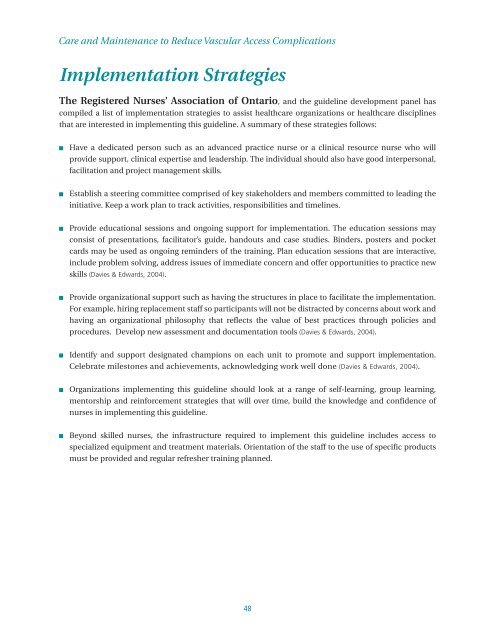Care and Maintenance to Reduce Vascular Access Complications
Care and Maintenance to Reduce Vascular Access Complications
Care and Maintenance to Reduce Vascular Access Complications
- No tags were found...
Create successful ePaper yourself
Turn your PDF publications into a flip-book with our unique Google optimized e-Paper software.
<strong>Care</strong> <strong>and</strong> <strong>Maintenance</strong> <strong>to</strong> <strong>Reduce</strong> <strong>Vascular</strong> <strong>Access</strong> <strong>Complications</strong>Implementation StrategiesThe Registered Nurses’ Association of Ontario, <strong>and</strong> the guideline development panel hascompiled a list of implementation strategies <strong>to</strong> assist healthcare organizations or healthcare disciplinesthat are interested in implementing this guideline. A summary of these strategies follows:■Have a dedicated person such as an advanced practice nurse or a clinical resource nurse who willprovide support, clinical expertise <strong>and</strong> leadership. The individual should also have good interpersonal,facilitation <strong>and</strong> project management skills.■Establish a steering committee comprised of key stakeholders <strong>and</strong> members committed <strong>to</strong> leading theinitiative. Keep a work plan <strong>to</strong> track activities, responsibilities <strong>and</strong> timelines.■Provide educational sessions <strong>and</strong> ongoing support for implementation. The education sessions mayconsist of presentations, facilita<strong>to</strong>r’s guide, h<strong>and</strong>outs <strong>and</strong> case studies. Binders, posters <strong>and</strong> pocketcards may be used as ongoing reminders of the training. Plan education sessions that are interactive,include problem solving, address issues of immediate concern <strong>and</strong> offer opportunities <strong>to</strong> practice newskills (Davies & Edwards, 2004).■Provide organizational support such as having the structures in place <strong>to</strong> facilitate the implementation.For example, hiring replacement staff so participants will not be distracted by concerns about work <strong>and</strong>having an organizational philosophy that reflects the value of best practices through policies <strong>and</strong>procedures. Develop new assessment <strong>and</strong> documentation <strong>to</strong>ols (Davies & Edwards, 2004).■Identify <strong>and</strong> support designated champions on each unit <strong>to</strong> promote <strong>and</strong> support implementation.Celebrate miles<strong>to</strong>nes <strong>and</strong> achievements, acknowledging work well done (Davies & Edwards, 2004).■Organizations implementing this guideline should look at a range of self-learning, group learning,men<strong>to</strong>rship <strong>and</strong> reinforcement strategies that will over time, build the knowledge <strong>and</strong> confidence ofnurses in implementing this guideline.■Beyond skilled nurses, the infrastructure required <strong>to</strong> implement this guideline includes access <strong>to</strong>specialized equipment <strong>and</strong> treatment materials. Orientation of the staff <strong>to</strong> the use of specific productsmust be provided <strong>and</strong> regular refresher training planned.48
















